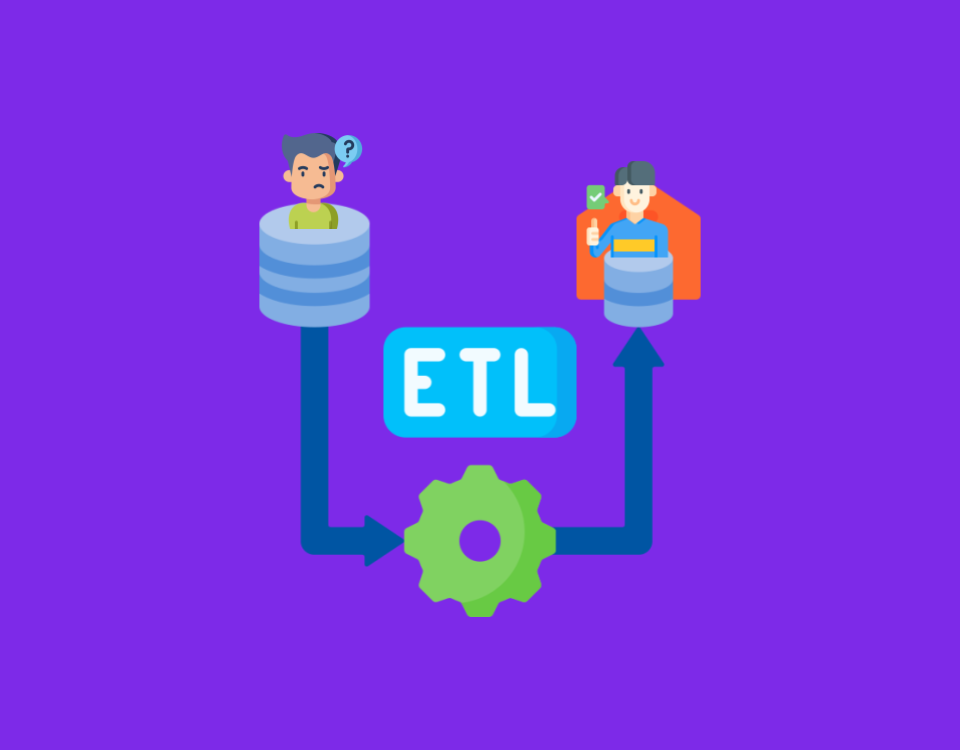Slow, inefficient ETL (Extract, Transform, Load) processes lead to delayed insights, high costs, and unreliable data pipelines. These issues are magnified when organizations fail to optimize how data is processed and managed. As businesses generate and consume increasing amounts of data, optimizing ETL pipelines becomes important to maintain competitive advantages.
Databricks, a unified data platform built on Apache Spark, offers a powerful environment for streamlining ETL processes.
Here we explore how businesses can transform their ETL processes into high-performance workflows that meet the demands of today's data-driven landscape.
What is ETL?
ETL (Extract, Transform, Load) is the backbone of data processing workflows that collect data from different sources, clean it up, transform it into a usable format, and load it into a destination for analysis.
- Extract: Data is retrieved from multiple systems—databases, files, APIs, IoT devices, etc. This raw data is often disorganized and must be gathered efficiently. The food delivery service, GrubHub extracts real-time order data, customer information, and restaurant menus from multiple sources like relational databases and APIs. These different sources must be integrated into their central data repository for further processing.
- Transform: After extraction, the data is cleansed and converted into a format suitable for analysis. This may involve filtering, removing duplicates, calculating aggregates, and applying business rules. Visa transforms transaction data by converting currency formats, detecting fraud patterns, and standardizing data across multiple financial institutions.
- Load: Transformed data is loaded into a target system, such as a data warehouse or data lake, where it can be used for business intelligence, machine learning, or reporting. Disney+ loads transformed viewer data into their cloud-based data warehouse (AWS Redshift), where it is used to generate insights for personalized content recommendations.
Efficient ETL pipelines ensure that high-quality data is available for decision-making. In industries where timely, accurate data is critical, optimizing each phase of the ETL process is vital.
What is Databricks for ETL?
Databricks is a unified data analytics platform that runs on Apache Spark, enabling efficient, large-scale ETL workflows. It's designed to handle massive datasets with distributed, parallel processing, making it a great fit for data pipelines that need to scale quickly.
Benefits of Using Databricks for ETL
- Scalability: Databricks can scale resources based on workload demands. Its ability to scale horizontally by adding more nodes allows companies to handle increasing data volumes without rearchitecting pipelines. Spotify processes petabytes of user activity data daily using Databricks, adjusting its cluster size during peak streaming times and scaling back during off-peak hours to save costs.
- In-memory Processing: Databricks processes data in-memory through Apache Spark, resulting in faster transformations compared to traditional disk-based ETL tools. HSBC, a global bank, used Databricks to improve in-memory transformations of transaction data, leading to faster fraud detection and compliance reporting.
- Cloud-Native Integration: Databricks seamlessly integrates with cloud storage solutions like AWS S3, Azure Data Lake, and Google Cloud Storage, simplifying the data ingestion process. Shopify leverages Databricks to ingest millions of daily transactions from its cloud databases (AWS S3) into its analytics platform to forecast sales trends and identify customer behavior patterns.
- Collaborative Workflows: With support for Python, SQL, Scala, and R, Databricks enables collaboration across data engineers, scientists, and business analysts, fostering a unified approach to building and optimizing ETL pipelines. The financial software company, Intuit uses Databricks to unify collaboration between data engineers and data scientists, optimizing their tax software by leveraging insights from large datasets on user behavior and market conditions.
What are ETL Pipelines for Databricks?
In Databricks, ETL pipelines consist of a series of interconnected steps that automate the flow of data from multiple sources into a target destination, such as a data lake or warehouse. These pipelines must be optimized for high performance, scalability, and cost-efficiency.
Databricks allows companies to build these pipelines in a distributed, cloud-based environment, which can handle batch processing, streaming data, and machine learning workloads at scale. However, optimizing these pipelines requires fine-tuning across each phase—extraction, transformation, and loading—to ensure efficient resource utilization, minimal latency, and low error rates.
Challenges in Databricks ETL Pipelines
- Handling Complex Data Sources: Databricks pipelines often pull data from various formats (e.g., JSON, Parquet, Avro) and sources, each of which requires different extraction mechanisms. Tesla extracts real-time vehicle sensor data and cloud storage log data for analytics and uses Databricks to streamline ETL pipelines that handle these disparate sources efficiently.
- Performance Optimization: Without proper tuning, large-scale transformations or joins in Databricks pipelines can lead to slow execution, high memory consumption, or inefficient data shuffling across nodes. FedEx optimizes its logistics ETL pipelines by partitioning datasets effectively, reducing unnecessary shuffling of shipping data between nodes, and improving delivery route optimizations.
- Ensuring Data Quality: Transformations in Databricks pipelines often deal with data validation, deduplication, and applying business rules. Failure to manage this step properly can lead to inaccurate analytics downstream. Salesforce ensures data integrity by running data quality checks during the transformation process in Databricks, cleaning customer interaction data, and applying business rules before loading it into their CRM system for reporting.
ETL Performance Metrics in Databricks
Monitoring the performance of ETL pipelines is essential for understanding inefficiencies and bottlenecks. Databricks provides a range of tools to help teams measure performance metrics, identify issues, and optimize pipelines.
What are the metrics to monitor?
| Metric | Description | Who did it? |
| Job Execution Time | Total time taken for an ETL job. Long execution times indicate inefficiencies. | Uber tracks job times to ensure real-time trip data processing. |
| Stage Latency | Measures time taken for each stage (extract, transform, load). | Netflix optimizes stage latency to process streaming data faster. |
| Shuffle Read/Write | Tracks data movement between Spark nodes. High shuffle times indicate poor data partitioning or joins. | Airbus reduced shuffle times for aircraft performance analytics. |
| Resource Utilization | CPU, memory, and disk usage across the cluster. Inefficiencies here may signal over-provisioned clusters. | Amex monitors resource usage in fraud detection pipelines. |
| Error Rates | Measures job failure rates or incorrect data output. High error rates suggest data quality issues. | Fitbit monitors error rates to ensure data integrity in health tracking. |
Why do metrics matter?
These metrics provide visibility into the health of ETL pipelines. Monitoring performance metrics allows businesses to:
- Pinpoint Obstacles: Slow execution times or high latency in a specific stage can highlight inefficiencies or bottlenecks that need attention.
- Improve Resource Management: Resource utilization data ensures that clusters are right-sized for the workload, avoiding both over-provisioning and under-provisioning of compute power.
- Enhance Data Reliability: Monitoring error rates reduces the likelihood of inaccurate analytics due to data loss or transformation errors.
Which tools to use for monitoring?
- Databricks Jobs UI: A built-in interface that shows detailed job execution timelines, resource utilization, and logs to help troubleshoot performance issues.
- Spark UI: Offers low-level insights into how Spark jobs execute within Databricks, including task completion, stage breakdowns, and shuffle operations.
- Third-party Monitoring Tools: Solutions like Datadog, Prometheus, or Grafana can be integrated with Databricks to provide deeper monitoring of infrastructure-level metrics, including CPU, memory, and disk usage.
Step-by-step ETL Optimization Guide
To optimize ETL pipelines in Databricks, it is essential to break down each phase of the pipeline (extraction, transformation, and loading) and apply targeted optimizations.
Data Extraction Optimization
- Parallelized Data Extraction: Use Spark’s distributed computing to parallelize data reads from multiple sources, reducing the time it takes to extract large datasets. DoorDash extracts real-time order data from multiple cities across the U.S. in parallel, using partitioned reads from their AWS S3 data lake to improve extraction times for analytics.
- Selective Data Pruning: Extract only the data you need, applying filters or constraints at the source level. This reduces the amount of data pulled into the pipeline, saving time and resources. 3M reduces data extraction overhead by filtering its manufacturing data by time and location before ingesting it into Databricks for further analysis.
- Delta Caching: Cache frequently accessed data in-memory using Delta Lake to reduce repeated extraction times, especially for iterative workloads or recurring jobs. PepsiCo caches sales data when processing regional sales reports, ensuring faster access to frequently queried datasets in its Databricks clusters.
Data Transformation Optimization
- Leverage Lazy Evaluation in Spark: Spark optimizes transformations through lazy evaluation, combining multiple transformations into a single execution plan, reducing redundant operations. Mastercard speeds up the transformation of transaction data by applying filters and aggregations in a single stage, reducing memory usage and processing time.
- Efficient Join Operations: Use broadcast joins for small datasets and distributed joins for larger ones to reduce shuffle times. Optimizing how data is joined in Spark can drastically cut down on execution times. Coca-Cola optimized its ETL pipelines that aggregate sales and inventory data from multiple regions by applying broadcast joins to smaller, frequently accessed lookup tables.
- Vectorized Operations: Apply vectorized processing (batch operations) instead of row-by-row transformations. Vectorization speeds up the transformation process by applying functions to whole columns of data at once. eBay uses vectorized transformations in Databricks to speed up the processing of its auction and sales data, improving insights into bidding patterns and buyer behavior.
- Partitioning and Data Skew Handling: Proper partitioning ensures data is evenly distributed across cluster nodes. Handling data skew—where a small number of partitions contain the majority of data—helps avoid node overloading. Home Depot ensures balanced partitioning of customer order data, avoiding data skew in its supply chain analytics pipeline.
Data Loading Optimization
- Batch Loading: Load data into target systems in large batches instead of inserting one row at a time. This minimizes network overhead and improves the throughput of loading processes. Warner Bros. improved the loading speed of its media usage data into cloud storage by switching from row-level inserts to batch loads, reducing ETL job runtimes.
- Use Columnar File Formats: Store data in columnar formats like Parquet or ORC, which are optimized for both storage and query performance. Columnar formats allow for better compression and faster reads. Toyota uses Parquet for storing its IoT sensor data from connected vehicles, improving both storage efficiency and query speed for predictive maintenance analytics.
- Optimize Schema Evolution: Make sure that schema changes in your target system (data warehouse or lake) are managed smoothly by implementing schema evolution in Databricks. This avoids pipeline failures when new columns or data types are introduced. Nestlé optimized their ETL pipeline to handle schema evolution when new product categories were introduced, ensuring that historical data remains compatible with updated schemas in their reporting system.
Resource Management and Cost Optimization
Databricks clusters can be costly if not managed properly, especially for large-scale ETL jobs. Efficient resource management is key to maintaining performance without inflating costs.
| Optimization Technique | Description | Who did it? |
| Auto-scaling Clusters | Dynamically scale the number of nodes in a cluster based on workload demand. Prevents over-provisioning of resources during low-usage periods. | Uber Eats uses auto-scaling to handle surges in meal orders during peak hours and scales down during off-hours to save on computing costs. |
| Spot Instances / Low-priority VMs | Leverage cheaper, interruptible instances for non-critical ETL jobs, reducing infrastructure costs by 60-70%. | Slack uses AWS Spot instances for its nightly batch ETL jobs, reducing infrastructure costs by 50% without compromising performance. |
| Cluster Auto-Termination | Set clusters to automatically shut down after a specified idle time. Helps prevent runaway costs caused by idle clusters. | Siemens configured auto-termination on its machine sensor data pipeline, saving thousands in costs by ensuring that clusters shut down after 15 minutes of inactivity. |
Advanced Tools and Techniques for ETL Optimization
Databricks offers a variety of advanced tools and techniques to further optimize ETL pipelines for large-scale environments.
- Delta Lake: Delta Lake provides ACID compliance, allowing for reliable ETL pipelines. It enables incremental updates, time-travel queries, and schema enforcement, all while improving query performance. Dell Technologies uses Delta Lake to handle incremental data updates for their customer support analytics platform, allowing them to easily manage late-arriving data and perform time-travel queries for historical analysis.
- Databricks Workflows: Automating ETL workflows in Databricks using built-in Workflows ensures jobs are orchestrated in the correct order, handling dependencies and retries. This removes the need for manual intervention and improves reliability. Heineken automates their ETL pipelines using Databricks Workflows to process global sales and production data, reducing errors and ensuring that all steps in the pipeline are executed in the correct sequence.
- Adaptive Query Execution (AQE): Adaptive Query Execution dynamically adjusts Spark query plans based on runtime statistics. AQE optimizes joins and reduces data shuffling by re-optimizing queries based on the size of the data being processed. Lyft uses AQE in Databricks to optimize its ride-sharing ETL pipeline, where dynamic query optimizations lead to faster processing of rider and driver data.
- Data Skew Optimization: Use techniques like data bucketing or salting to address data skew, where certain partitions contain much more data than others. This ensures balanced processing across the entire cluster. Ryanair tackled data skew in their ETL pipeline by partitioning customer booking data based on time and region, ensuring that no single partition was overloaded with data from high-traffic regions.
Case Studies
Retail Industry: Optimizing Burberry with Databricks ETL
Burberry, a major luxury fashion retailer, uses Databricks to gain insights into customer behavior and improve inventory management across its global stores. The company handles vast amounts of data from online transactions, in-store sales, and social media. Using Databricks for ETL, Burberry optimized data extraction by integrating data sources, including CRM, ERP, and point-of-sale systems, into a single cloud data lake.
With Databricks’ Spark engine, they transform and analyze these data sets in real-time, identifying patterns in customer preferences and seasonal demands. By leveraging Databricks’ auto-scaling feature, Burberry saved on compute costs, only using additional resources during high-demand periods.
The company also reduced its ETL processing time by 40%, allowing analysts to access insights faster and enabling data-driven decisions on inventory and marketing strategies. This optimization has helped Burberry better predict trends, streamline operations, and improve customer satisfaction.
Healthcare Industry: Optimizing CVS Health with Databricks ETL
CVS Health, a leading healthcare provider and pharmacy chain, needed to unify data from millions of prescriptions, health services, and customer interactions across thousands of locations. With Databricks ETL, CVS Health integrated data from electronic health records (EHRs), customer loyalty programs, and supply chain systems into a single, HIPAA-compliant data lake.
This integration enabled CVS to analyze patient data in real-time, improving medication adherence programs and personalizing patient outreach. CVS used Databricks’ delta lake for efficient data storage, reducing duplication and storage costs while improving query performance by 30%.
By utilizing spot instances on AWS, CVS optimized compute costs, making large-scale data processing more affordable. This ETL optimization has allowed CVS Health to rapidly respond to healthcare trends, improve service personalization, and enhance patient engagement through more targeted health interventions.
Finance Industry: Optimizing HSBC with Databricks ETL
HSBC, one of the world’s largest banking institutions, manages enormous volumes of financial transactions and customer data daily. To comply with strict regulatory requirements and detect fraud in real-time, HSBC implemented Databricks ETL.
HSBC consolidated data from global banking systems, transactional data, and regulatory reports into a central Databricks environment. The Spark-based ETL process enabled HSBC to process billions of records quickly and detect anomalies in real-time, significantly improving fraud detection accuracy.
By optimizing transformations through efficient join operations and batch processing, HSBC reduced ETL processing time by 50%.
Using Databricks’ auto-scaling feature helped HSBC control compute costs by adjusting resources according to transaction volumes. This ETL optimization has enhanced HSBC’s ability to prevent financial crimes, meet compliance standards, and deliver secure, timely services to its clients.
Conclusion
Inadequate ETL pipelines can create a performance slowdown, increase operational costs, and delay critical business insights. Databricks offers a scalable, fast, and flexible environment to overcome these challenges.
By implementing these optimization techniques, you can significantly improve the performance, reliability, and scalability of your Databricks ETL pipelines. Remember, the journey towards optimization is continuous. Continuously monitor your pipelines, identify bottlenecks, and apply the most suitable techniques to ensure that your data is always ready to fuel your business insights.
Still, struggling with slow ETL pipelines or poor data quality? Let Cloudaeon’s data experts help you streamline your processes and maximize your data’s potential.




